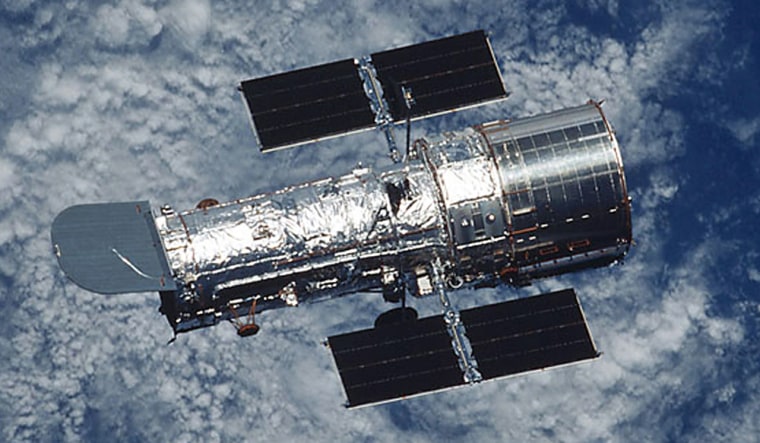Scientists are eagerly awaiting a much-needed facelift planned for the world's favorite space telescope.
This fall, NASA astronauts plan to take a final space shuttle trip to fix the aging Hubble Space Telescope.
Set to fly Oct. 8 from NASA's Kennedy Space Center in Florida, the mission will carry seven astronauts aboard the shuttle Atlantis to upgrade the 18-year-old Hubble. Ground crews at Kennedy Space Center are hard at work on repairs to Launch Pad 39A, which suffered damage during the shuttle Discovery's liftoff on May 31. The work is expected to be finished in time for Atlantis' launch.
"Hubble's been flying for over 18 years, and although it's old, there's still a lot of great science left in this telescope," Preston Burch, Hubble program manager, said at a briefing Tuesday at NASA's Goddard Space Flight Center. "We believe that [this mission] is going to enable us to finally unleash the full potential of the Hubble Space Telescope."
The STS-125 mission will be the fifth trip to repair the orbiting telescope, which has been circling Earth about every 97 minutes since it launched in April 1990. The planned 11-day mission is slated to install new equipment and repair broken instruments during five spacewalks.
New additions
Atlantis is scheduled to deliver the Wide Field Camera 3, which was designed to image the distant universe in a broad range of wavelengths, from near ultraviolet light through optical light and into the near infrared. It will be particularly adept at studying some of the oldest, most distant galaxies in the universe, whose light has been redshifted to the infrared range.
"We have no idea what the universe looks like at these very high redshifts," said Matt Mountain, director of the Space Telescope Science Institute. "Our first hint will come from Wide Field Camera 3."
The mission is also due to bring Hubble the Cosmic Origins Spectrograph, an instrument that can break up light into its constituent colors to reveal the chemical makeup and other fundamental properties of heavenly objects.
In addition to the new scientific instruments, Atlantis is set to deliver a set of six new and improved gyroscopes, which help stabilize the telescope, to replace its old six, three of which are broken. The shuttle mission is also slated to repair some broken instruments aboard the observatory, and bring new batteries and thermal blankets that should help the telescope operate until at least 2013.
The crew is also planning to install a docking port called a Soft Capture Mechanism to the observatory. When the telescope is ready to be retired, a future unmanned spacecraft could attach to this device to steer Hubble on a controlled dive down to its demise.
New and improved
NASA hopes the upcoming upgrades will help Hubble have a healthy life for a while yet. To that end, they've planned a packed mission to leave the telescope in the best shape possible.
The numerous activities scheduled for the five busy spacewalking days will be a challenging undertaking, mission managers said.
"Even if we just get one day [of spacewalking repairs] in, we'd have a much better telescope than we have now," said Keith Walyus, operations manager for the Hubble Space Telescope servicing mission. "If we get all this done — wow, that's going to be absolutely amazing."
The mission has had a rocky history. Originally cancelled in the wake of the Columbia disaster in 2003, for a while NASA deemed it too risky and expensive a venture.
NASA considered sending a robotic repair mission to Hubble instead, but eventually decided a manned mission was the only way to accomplish what needed to be done.
"The technology they were looking at is amazing," Walyus said of the proposed robotic fixes, "but it's just not the same as a human. This was built to be worked on by humans."
Ultimately the strong public and political support for the mission helped influence NASA to decide to return to the space telescope one last time.
"The American people stood up and said wait a minute, not so fast, this is our telescope," David Leckrone, Hubble senior project scientist at Goddard, said of the response to the mission's cancellation.
Beloved by many
The telescope achieves its amazing feats by orbiting 360 miles (575 kilometers) above the surface of the Earth. From that height, Hubble can bypass our planet's thick atmosphere, which blocks out light and distorts the view from space — an effect akin to looking at trees from the bottom of a swimming pool.
While Hubble's 94.5-inch-wide (2.4-meter-wide primary mirror would be considered dinky compared with the largest ground-based observatories (the W.M. Keck Observatory in Mauna Kea, Hawaii, has two scopes with 10-meter, or 400-inch, primary mirrors), in space it is enough to observe the distant cosmos in unmatched detail.
These visions have produced not only groundbreaking scientific discoveries, but also unprecedented enthusiasm from nonscientists.
"When the public saw for the first time the absolute stunning beauty of the universe we live in, that was a major shift in the way people looked at the world," Leckrone said. "I think there's a big element of pride on the part of the American people in having produced Hubble and used it in this way. I think as a species we all take collective pride in, hey, this is something we did, and it was something very hard to do."
